brake light Acura TSX 2010 Owner's Manual
[x] Cancel search | Manufacturer: ACURA, Model Year: 2010, Model line: TSX, Model: Acura TSX 2010Pages: 524, PDF Size: 12.34 MB
Page 60 of 524
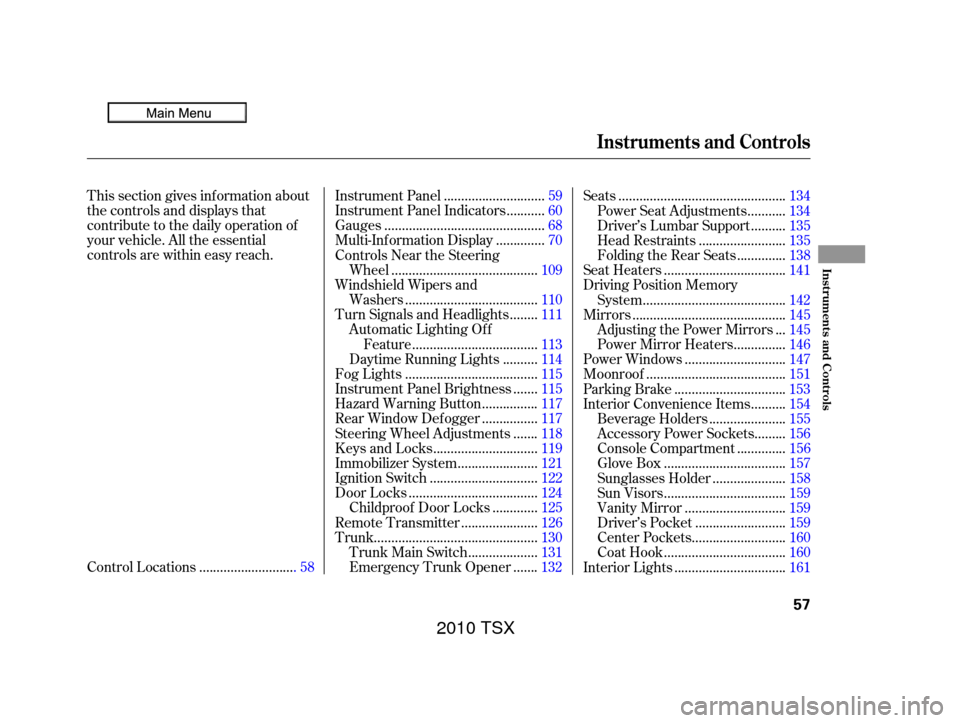
This section gives inf ormation about
the controls and displays that
contribute to the daily operation of
your vehicle. All the essential
controls are within easy reach............................
Control Locations . 58............................
Instrument Panel .59
..........
Instrument Panel Indicators . 60
.............................................
Gauges .68
.............
Multi-Inf ormation Display . 70
Controls Near the Steering .........................................
Wheel .109
Windshield Wipers and .....................................
Washers .110
.......
Turn Signals and Headlights . 111
Automatic Lighting Off ...................................
Feature .113
.........
Daytime Running Lights . 114
.....................................
Fog Lights .115
......
Instrument Panel Brightness . 115
...............
Hazard Warning Button . 117
...............
Rear Window Def ogger . 117
......
Steering Wheel Adjustments . 118
.............................
Keys and Locks .119
......................
Immobilizer System .121
..............................
Ignition Switch .122
....................................
Door Locks .124
............
Childproof Door Locks . 125
.....................
Remote Transmitter .126
..............................................
Trunk .130
...................
Trunk Main Switch . 131
......
Emergency Trunk Opener . 132...............................................
Seats .134
..........
Power Seat Adjustments . 134
.........
Driver’s Lumbar Support . 135
........................
Head Restraints .135
.............
Folding the Rear Seats . 138
..................................
Seat Heaters .141
Driving Position Memory ........................................
System .142
...........................................
Mirrors .145
..
Adjusting the Power Mirrors . 145
..............
Power Mirror Heaters . 146
............................
Power Windows .147
.......................................
Moonroof .151
...............................
Parking Brake .153
.........
Interior Convenience Items . 154
.....................
Beverage Holders .155
........
Accessory Power Sockets . 156
.............
Console Compartment . 156
..................................
Glove Box .157
....................
Sunglasses Holder .158
..................................
Sun Visors .159
............................
Vanity Mirror .159
.........................
Driver’s Pocket .159
..........................
Center Pockets .160
..................................
Coat Hook .160
...............................
Interior Lights .161
Instruments and Controls
Inst rument s and Cont rols
57
2010 TSX
Page 62 of 524
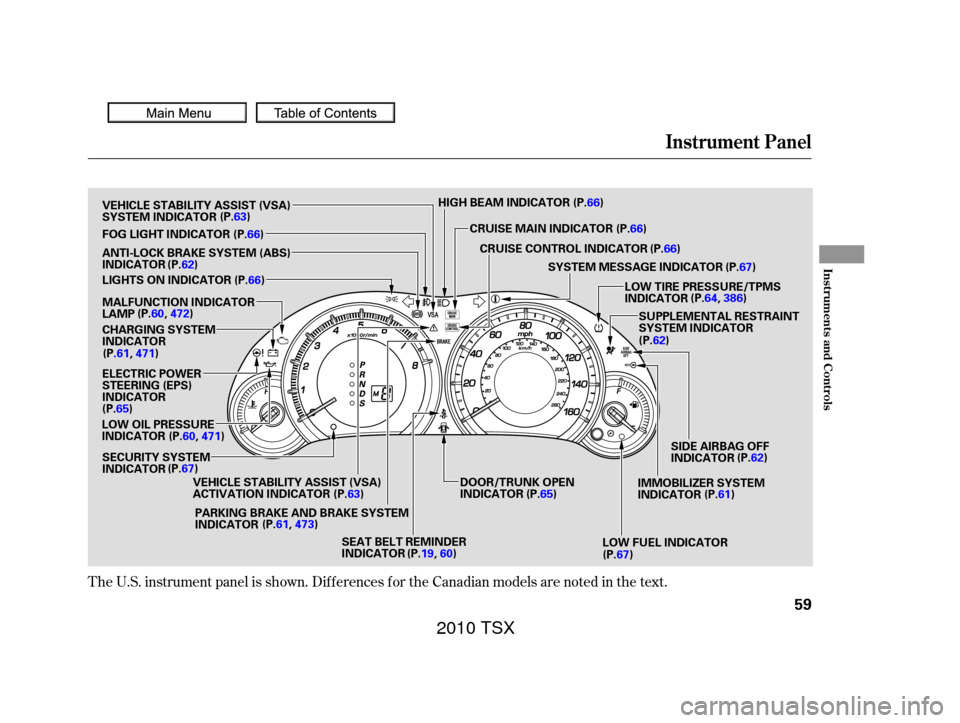
The U.S. instrument panel is shown. Dif f erences f or the Canadian models are noted in the text.
Instrument Panel
Inst rument s and Cont rols
59
FOG LIGHT INDICATOR
SECURITY SYSTEM
INDICATOR VEHICLE STABILITY ASSIST (VSA)
SYSTEM INDICATOR
ANTI-LOCK BRAKE SYSTEM (ABS)
INDICATOR
CHARGING SYSTEM
INDICATOR
ELECTRIC POWER
STEERING (EPS)
INDICATOR LIGHTS ON INDICATOR
MALFUNCTION INDICATOR
LAMP
LOW OIL PRESSURE
INDICATOR SEAT BELT REMINDER
INDICATOR
VEHICLE STABILITY ASSIST (VSA)
ACTIVATION INDICATOR
LOW FUEL INDICATORIMMOBILIZER SYSTEM
INDICATOR
SIDE AIRBAG OFF
INDICATOR
SYSTEM MESSAGE INDICATOR
HIGH BEAM INDICATOR
CRUISE CONTROL INDICATOR
DOOR/TRUNK OPEN
INDICATOR LOW TIRE PRESSURE/TPMS
INDICATOR
(P.63)
(P.66)
(P.62) (P.66)
(P.65) (P.67) (P.63)
(P.19,60) (P.65)
(P.67) (P.
61)(P.
62)
(P.62) SUPPLEMENTAL RESTRAINT
SYSTEM INDICATOR
(P.
67)
(P.66)
CRUISE MAIN INDICATOR (P.66)
PARKING BRAKE AND BRAKE SYSTEM
INDICATOR (P.66)
(P.60, 472)
(P .61, 471)
(P.60, 471)
(P.61,473) (P.64,
386)
2010 TSX
Page 117 of 524
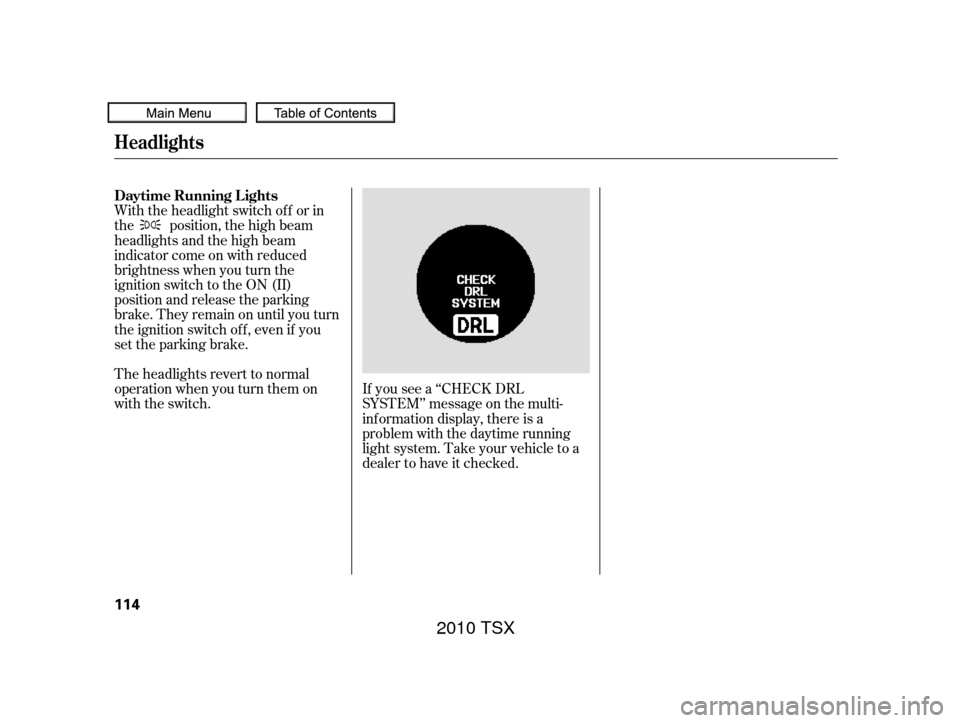
With the headlight switch of f or in
the position, the high beam
headlights and the high beam
indicator come on with reduced
brightness when you turn the
ignition switch to the ON (II)
position and release the parking
brake. They remain on until you turn
the ignition switch of f , even if you
set the parking brake.
The headlights revert to normal
operation when you turn them on
with the switch.If you see a ‘‘CHECK DRL
SYSTEM’’ message on the multi-
inf ormation display, there is a
problem with the daytime running
light system. Take your vehicle to a
dealer to have it checked.
Headlights
Daytime Running L ights
114
2010 TSX
Page 156 of 524

To apply the parking brake, pull the
lever up f ully. To release it, pull up
slightly, push the button, and lower
the lever. The parking brake
indicator on the instrument panel
should go out when the parking
brake is f ully released (see page ).If you drive without releasing the
parking brake, a beeper will sound,
and you will also see a ‘‘RELEASE
PARKING BRAKE’’ message on the
multi-inf ormation display.
61
Parking Brake
Inst rument s and Cont rols
153
PARKING BRAKE LEVER
Driving the vehicle with the parking
brake applied can damage the rear
brakes and hubs. A beeper will sound if
the vehicle is driven with the parking
brake on.
2010 TSX
Page 302 of 524

You can decrease the set cruising
speed in any of these ways:If you need to decrease your
speed quickly, use the brakes as you
normally would.
Press and hold the SET/DECEL
button. Release the button when
you reach the desired speed.
To slow down in very small
amounts, tap the SET/DECEL
button repeatedly. Each time you
do this, your vehicle will slow
down about 1 mph (1.6 km/h).
Tap the brake or clutch pedal
lightly with your f oot. The
CRUISE CONTROL indicator on
the instrument panel will go out.
When the vehicle slows to the
desired speed, press the SET/
DECEL button.
You can increase the set cruising
speed in any of these ways:
Press and hold the RES/ACCEL
button. When you reach the
desired cruising speed, release the
button.
Push on the accelerator pedal.
Accelerate to the desired cruising
speed, then press the SET/
DECEL button.
To increase the speed in very
small amounts, tap the RES/
ACCEL button. Each time you do
this, your vehicle will speed up
about 1 mph (1.6 km/h).
Cruise control may not hold the set
speed when you are going up and
down hills. If your vehicle speed
increases going down a hill, use the
brakes to slow down. This will cancel
thecruisecontrol.Toresumetheset
speed, press the RES/ACCEL button.
The CRUISE CONTROL indicator
on the instrument panel will come
back on.
CONT INUED
Changing the Set Speed
Cruise Control
Features
299
NOTE:
2010 TSX
Page 353 of 524

Reach in between the hood and
the f ront grille with your f ingers.
The hood latch handle is above
the ‘‘A’’ logo. Push this handle up
to the right until it releases the
hood. Lif t the hood.
Park the vehicle, and set the
parking brake. Pull the hood
release handle located under the
lower lef t corner of the dashboard.
The hood will pop up slightly. If the hood latch handle moves stif f ly,
or if you can open the hood without
lif ting the handle, the mechanism
should be cleaned and lubricated.
2.
1.
Service Station Procedure
Opening and Closing the Hood
350
LATCH
HOOD RELEASE HANDLE
2010 TSX
Page 360 of 524
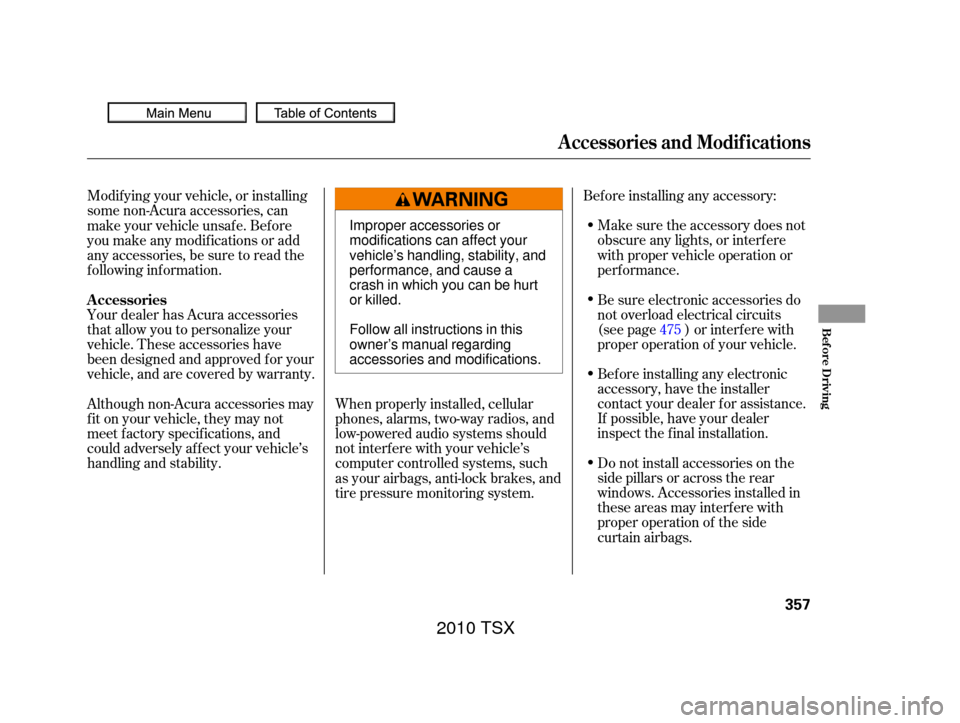
Bef ore installing any accessory:Make sure the accessory does not
obscure any lights, or interf ere
with proper vehicle operation or
perf ormance.
Bef ore installing any electronic
accessory, have the installer
contact your dealer for assistance.
If possible, have your dealer
inspect the f inal installation.
Do not install accessories on the
side pillars or across the rear
windows. Accessories installed in
theseareasmayinterferewith
proper operation of the side
curtain airbags.
Modif ying your vehicle, or installing
some non-Acura accessories, can
make your vehicle unsaf e. Bef ore
you make any modif ications or add
anyaccessories,besuretoreadthe
f ollowing inf ormation.
Your dealer has Acura accessories
that allow you to personalize your
vehicle. These accessories have
been designed and approved f or your
vehicle, and are covered by warranty.
Although non-Acura accessories may
f it on your vehicle, they may not
meet f actory specif ications, and
could adversely af f ect your vehicle’s
handling and stability.
Be sure electronic accessories do
not overload electrical circuits
(see page ) or interf ere with
proper operation of your vehicle.
When properly installed, cellular
phones, alarms, two-way radios, and
low-powered audio systems should
not interf ere with your vehicle’s
computer controlled systems, such
as your airbags, anti-lock brakes, and
tire pressure monitoring system. 475
A ccessories
A ccessories and Modif ications
Bef ore Driving
357
Improper accessories or
modifications can affect your
vehicle’s handling, stability, and
performance, and cause a
crash in which you can be hurt
or killed.
Follow all instructions in this
owner’s manual regarding
accessories and modifications.
2010 TSX
Page 385 of 524

Always use the parking brake when
you park your vehicle. Make sure
the parking brake is set f irmly, or
your vehicle may roll if it is parked
on an incline.
If your vehicle has an automatic
transmission, set the parking brake
bef ore you put the transmission in
Park. This keeps the vehicle f rom
moving and putting pressure on the
parking mechanism in the
transmission.Make sure the parking brake is
f ully released bef ore driving away.
Driving with the parking brake
partially set can overheat or
damage the rear brakes. If the vehicle is f acing uphill, turn
the front wheels away from the
curb. If your vehicle has a manual
transmission, put it in f irst gear.
If the vehicle is f acing downhill,
turn the front wheels toward the
curb. If your vehicle has a manual
transmission, put it in reverse gear.
Make sure the moonroof and the
windows are closed.
Turn of f the lights.
Place any packages, valuables, etc.,
in the trunk or take them with you.
Lock the doors.
Check the indicator on the
instrument panel to verif y that the
security system is set.
Never park over dry leaves, tall
grass, or other f lammable
materials. The hot three way
catalytic converter could cause
these materials to catch on fire.
Parking T ips
Parking
382
2010 TSX
Page 386 of 524

Your vehicle is equipped with disc
brakes at all f our wheels. A power
assist helps reduce the ef f ort needed
on the brake pedal. The emergency
brake assist system increases the
stopping f orce when you depress the
brake pedal hard in an emergency
situation. The anti-lock brake system
(ABS) helps you retain steering
control when braking very hard.
Resting your f oot on the pedal keeps
the brakes applied lightly, builds up
heat, reduces their ef f ectiveness and
reduces brake pad lif e. In addition,
f uel economy can be reduced. It also
keeps your brake lights on all the
time, conf using drivers behind you.The hydraulic system that operates
the brakes has two separate circuits.
Each circuit works diagonally across
the vehicle (the lef t-f ront brake is
connected with the right-rear brake,
etc.). If one circuit should develop a
problem, you will still have braking
at two wheels.
All f our brakes have audible brake
wear indicators.
If the brake pads need replacing, you
will hear a distinctive, metallic
screeching sound when you apply
the brake pedal. If you do not have
the brake pads replaced, they will
screech all the time. It is normal f or
the brakes to occasionally squeal or
squeak when you apply them.
Constant application of the brakes
when going down a long hill builds
up heat and reduces their ef f ective-
ness. Use the engine to assist the
brakes by taking your f oot of f the
accelerator and downshif ting to a
lower gear.
Check the brakes after driving
through deep water. Apply the
brakes moderately to see if they f eel
normal. If not, apply them gently and
f requently until they do. Be extra
cautious and alert in your driving.
Braking System
Brake Pad Wear Indicators Braking System DesignDriving
383
2010 TSX
Page 401 of 524
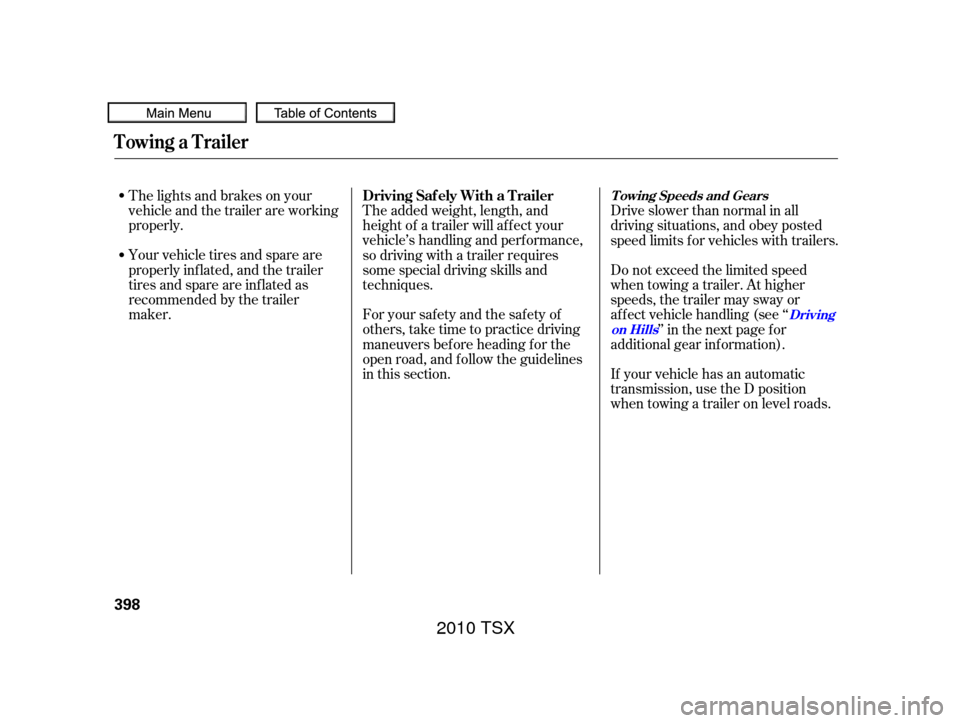
The lights and brakes on your
vehicle and the trailer are working
properly.
Your vehicle tires and spare are
properly inf lated, and the trailer
tires and spare are inflated as
recommended by the trailer
maker.The added weight, length, and
height of a trailer will af f ect your
vehicle’s handling and perf ormance,
so driving with a trailer requires
some special driving skills and
techniques.
Foryoursafetyandthesafetyof
others,taketimetopracticedriving
maneuvers bef ore heading f or the
open road, and f ollow the guidelines
in this section. Driveslowerthannormalinall
driving situations, and obey posted
speed limits f or vehicles with trailers.
Do not exceed the limited speed
when towing a trailer. At higher
speeds,thetrailermayswayor
affect vehicle handling (see ‘‘
’’ in the next page f or
additional gear information).
If your vehicle has an automatic
transmission, use the D position
when towing a trailer on level roads.
Towing a Trailer
Driving Saf ely With a T railerT owing Speeds and Gears
Driving
on Hills
398
2010 TSX